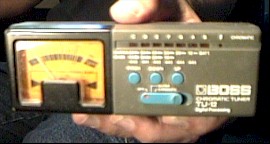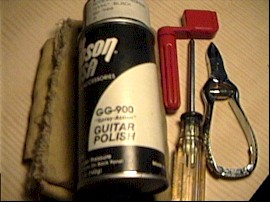
Beginning Guitar
I -
Lesson 1
Tuning and
Strings
Lyle:
Besides teaching you how to play music on your guitar, I will help you on the
following topics: how to choose and buy a guitar, how to choose an amp -
effects, strings - what kind to get, when and how to restring, picks, basic
tools you need, how to tune your guitar, anatomy of the guitar - electric and
acoustic, how to hold the guitar, how to hold the pick, using a strap, how much
should you practice?, how I learned to play guitar, how long will it take until
you get good?, where do you put your fingers?, how to read TAB, chords,
strumming, finger picking, scales, playing melodies, finger exercises, music
theory, ear training, basic song structures, chord progression formulas, all the
different guitar effects noises and techniques, and a guide to reading all the
different TAB symbols.
Lyle: There are so many things to cover so let's
get started!
Tuning
Lyle: This is the hardest part for the
beginning guitarist, how to tune your guitar. I strongly
suggest you buy an electronic tuner from the music store. Here's an example of
one:
electric
tuner

Lyle: A good electric tuner can cost anywhere from
$20 - $50. Ask your sales person to show you how to use it before you leave the
store with it.
Lyle: Before you can play anything you need to
have a tuned Guitar. The
standard tuning for a guitar is:
STRING NOTE
1st
string (the thin one) - E
2nd string - B
3rd
string - G
4th string - D
5th string - A
6th string (the big string)
- E
tuning

Lyle: To help you remember the name of each
string, just remember this silly phrase: Easter
Bunnies Get Drunk
After Easter. That is from string
1 through 6.
Lyle: Here's an interactive TAB file. It has the
correct tunings notes of each string. Click on the TAB file, it will load over
to the right side of the page to the interactive TAB player. Then click on Load
Media, or Media, you will now see and hear the TAB file playback. You'll hear
the sound of my guitar. Match up your strings to the sounds of mine by turning
your tuning pegs. Notice you're starting with the low/big E
string.
tuning
1
Lyle:
Remember, tuning is difficult for most beginners. That's why I suggest getting
and using an electronic tuner so you don't waste your time and patients trying
to tune.
Lyle: There are several ways to tune besides
using a tuner. You can tune to yourself by following these few steps:
-Put your finger on the
5th fret on the E string. That should match the tone on the open A string. Turn
the A tuning key until they match.
-Put your finger on the
5th fret on the A string. That should match the tone on the open D string. Turn
the D tuning key until they match.
-Put your finger on the
5th fret on the D string. That should match the tone on the open G string. Turn
the G tuning key until they match.
-Put your finger on the
4th fret on the G string. That should match the tone on the open B string. Turn
the B tuning key until they match.
-Put your finger on the 5th fret on the B string. That should match the
tone on the open E string. Turn the E tuning key until they
match.
tuning 2
tuning 2
Lyle:
Always tune in the SHARP direction. Sharp is high, Flat is low. Suppose you are
trying to tune the fifth string to A. Currently the string is flat. In order to
tune properly you need to turn the tuning gear until you hit A. If you go SHARP,
the WRONG thing to do is to turn the gear down until you hit A. The reason this
is incorrect is because there is still a minute amount of slack in the tuner--no
matter how good the tuner is, there is ALWAYS some slack.
Lyle: If
you go too far sharp, the PROPER way to tune is to turn the gear so that the
resulting note is DELIBERATELY flat. In other words, going back to our example,
if you overshoot your A note, then turn the tuner so you are FLATTER than A. Now
give the string a tug, as you would do when you are stretching, the slack in the
tuner will give. Now tune towards the A, being careful not to overshoot. If you
overshoot, repeat the process. The key is to tune in the SHARP direction
only!
Lyle: Another way to tune is by
using the sound of harmonics. To make a harmonic, or "that bell sound", gently
touch the string, don't push down on it, right on top of the fret wire at the
5th fret, pluck the string, then move your finger away from the string. You
should hear a high pitch sound. Also, use the bridge pickup on your guitar and
turn up the volume, these harmonic sounds can be hard to hear at first. Match
the 5thret of the big string to the 7th fret of the 5th string using harmonics.
If it's out of tune, change the 5th string. Here's a TAB file and video that can
help you see and hear how this is done across all the strings. The third and
second strings are tuned normal, without using harmonics:
tuning with harmonics
tuning with harmonics
Strings
Lyle: There
are 3 basic types of strings for the 3 types of guitars: Nylon for classical
acoustic guitars, Bronze wound/steel for steel string acoustic guitars, and
Nickel wound/steel for electric guitars.
Lyle: There are many
different companies that make guitar strings such as Ernie Ball, Dean Markley,
GHS, and D'Addario. I like them all. Strings come in sets ranging in different
tensions from extra light to heavy gauge. The thicker or heavier the gauge of
string, the harder it is to push down but the bigger the tone is. I suggest to
you, as a beginner, is to start with light gauge strings so your fingers wont get
too sore. For my acoustic guitars I use a medium-light gauge string size and on
my electric guitars I use a light gauge.
Lyle: Strings get old and dirty from the acidic
sweat and oils from your hand. The strings will start to loose their original
shiny appearance and become dull and muffled sounding. They also can become
brittle and break on you and hard to keep in tune. To keep your strings clean
and long lasting you should wash your hands before you play, then wipe down the
strings and fretboard with a soft cloth after you're done playing. How much you
play and how clean you keep the strings depends on how often you should change
your strings. I'd say once or twice a year for acoustic guitars, more often for
electric guitars because they have smaller strings and become dead faster. I
change strings on my main electric guitar once a week because I play it so much.
New strings and a clean fretboard feels good on my hand and also the tone is
best on new strings.
Lyle: The basic tools you need for your guitar,
besides an electric tuner, are
simply:
basic tools
needed

Lyle: A soft cleaning cloth, guitar polish
(available from your local music store), peg winder, wire cutter, and a small
Phillips head screwdriver.
Lyle: It's easy to change your strings on your
guitar but the first time can be a challenge. I suggest you ask your local music
store dealer or teacher to show you once. I've made a video clip to show you how
to do it. Here's a demonstration video that I hope helps
you:
restringing
video
Lyle:
Guitar picks are fun to pick out. They come in every color imaginable and
sometimes include graphics. The most common material used is plastic, but picks
can be made from almost anything - stone, metal, glass, and even felt! There are
also many shapes, sizes and thicknesses to choose from. I suggest you start off
with a standard plastic type of pick, medium gauge and the normal shape
>
standard guitar
pick

Lyle: That's all for this lesson on tuning and
your strings. Next you'll learn how to play stuff!